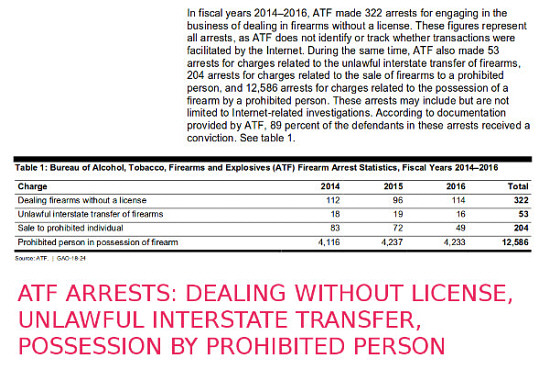

ATF Arrests for 2014, 2015, 2016;
Four Crimes, Tiny Numbers
![]()

By Dean Weingarten. January 16th, 2018
Article Source
In a recent Government Accounting Office report to Congress, most have focused on the firearm owners who refuse to commit crimes or fall for stings created by the ATF. Buried in the report is a chart showing how incredibly few legal gun owners are arrested each year for gun violations.
The chart shows the number of arrests made in three years, 2014, 2015, and 2016, for four crimes. The number of arrests are tiny, showing how law abiding gun owners are.
The four crimes are these:
Dealing firearms without a license
Unlawful interstate transfer of firearms
Sale to prohibited individual
Prohibited person in possession of firearm
The chart below shows the numbers.

Dealing firearms without a license averages 107 arrests a year. There are about 125,000 federal firearms licenses in the United States of various types. There are about a hundred million firearm owners (30% of the U.S. population). The chances of a firearm owner being arrested for dealing without a license is roughly one in a million per year.
Unlawful interstate transfer of firearms averages about 18 a year. It is hardly noticeable.
Sales to prohibited individuals are in between, about 68 a year. Far less than 1 per million firearms owners.
These are only Federal arrests, not state arrests. Most states have a number of categories of prohibited possessors. These categories may differ significantly from the Federal categories. Some states will mirror the Federal rules, some will not.
My suspicion is the vast majority of prohibited possessor arrests and prosecutions are done at the state level, but almost no state prosecutions are done for dealing firearms without a license or unlawful interstate transfer of firearms. Most states do not require a license to sell firearms.
There may be a significant number of state prosecutions for sales to prohibited individuals. Some states have a prohibition on those sales. But the offense is hard to prove, while illegal possession is relatively easy.
Firearm dealers and legal firearm owners are extremely law abiding.
The numbers draw into question the rational for the gun control act of 1968. The large number of violations occur with people who are prohibited possessors, and that is a crime in most of the states, without federal law.
When the Gun Control Act of 1968 (GCA 1968) was passed, crime increased. It was only after states started implementing shall issue carry permits that crime rates started to drop. Today, crime rates are back to the levels they were before GCA 1968 was passed.
Maybe we do not need a BATFE to regulate firearm sales. The ATF did not exist before 1972. They have a built a bad reputation since then.
Focusing on the weapon used is based on false assumptions about reality.
Weapons do not create crime or motives. It seems the number of guns in society have little to do with the number of crimes in society. To reduce the number of crimes, reduce the number of criminals, or keep them locked up and separate from the rest of the population.
Keeping weapons out of the hands of those prone to violence may do some good. As the arrests show, the most effective way to do this is to focus on the offender, in this case, the prohibited possessor.
Several programs have shown the removal of a small but very violent number of career criminals, can have a dramatically lower the homicide rate. Project Exile is an example. David Kennedy is worth reading to show how it can be done.
©2018 by Dean Weingarten: Permission to share is granted when this notice and link are included. Gun Watch
![]()

























